Apples
The mainstay of the orchard and, if room for only one fruit tree, then usually its an Apple
In and around the Trials Garden we have over 45 varieties planted together with many crabapples. None of the trees are sprayed which gives a good indication as to their resistance to common problems such as scab and canker. Based on our findings over the years we now mainly recommend the newer, disease resistant varieties although not exclusively. Remember also that just because a variety does no good in my garden doesn't mean it won't in yours, I can't grow James Grieve but many customers can (even though they say they don't spray!) Either way, we can't stock every variety so we stick to the ones that do well with us or get requested for on tasting days. We have access to hundreds of varieties and these can be added to our order if placed in mid summer
Choice of Rootstocks
Apples have a wide range of rootstocks to suit many purposes and soil types. It is vital to choose the right one when buying and here at Meynell Langley Gardens we can give sound advice on all aspects of roostock choice, pruning and after care.
APPLE ROOTSTOCKS
M27 VERY DWARF
small trees or containers but must be good soil or use M9
M9 DWARF
Dwarf again but more tolerant of poorer soils
M26 SEMI-DWARF
For more compact trained trees or larger bushes
MM106 SEMI-VIGOROUS
For larger trained and free standing trees
MM111/25 VERY VIGOROUS
for replanting older, heritage orchards.
Only to order
VARIETIES GROWN IN THE TRIALS GARDEN
Alkmene
eater
Small, bright red apples with great flavour. Now no longer stocked but isone of the most important parents of many new varieties, passing on its colour and flavours . RedWindsor, a more colourful sport, has now replaced it
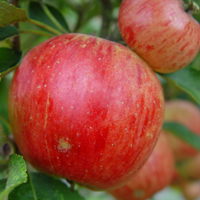
Adams Permain
eater
Dark reddish brown fruit. Good flavour and aromatic and an excellent keeper till March. Good for all areas of the UK (Norfolk/Hereford 19th century)
Allington Pippin
eater
Pale yellow fruit flushed red. Sharp and juicy with a pronounced pineapple flavour. Not self-fertile but keeps till December (Lincoln 19th century)
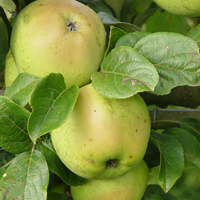
Arthur Turner
cooker
One of the most attractive flowers of any apple. Large yellow green fruit that cooks to a puree and needs hardly any extra sugar. Picks September and keeps into November.
Ashmeads Kernel
eater
Pale green with slight flush and some colour. Sharp, intense flavour. Will keep into February.
Blenheim Orange
cooker or eater
An old variety (Oxford 1740) with large green fruit and a few stripes. Vigorous, best on dwarf rootstock and also a partial tip bearer (see notes). Stores into January. Nutty taste with sweet, crumbly texture. Classed as the best of the dual purpose varieties. Has now been removed as it struggled to fruit as an espalier.
Bountiful
cooker
I like this cooker because it fills the gap before the Bramley's are ready. Slices retain their shape while cooking. A new, disease resistant variety and excellent garden tree (Kent 1964)
Bramley's Seedling
cooker
The cooking apple which is hard to beat. Vigorous, so needs a dwarfing rootstock and a partial tip bearing variety. Not self fertile -needs a pollinator (see notes). From Nottingham, 19th century.
Captain Kidd
dual purpose
An easy to grow self-fertile apple with an orange flush. Sweet flavour and also bakes well. No vices and does well in all areas. Picks Sept. keeps into the new year. Good container variety.
Cox's Orange Pippin
The eating variety to which all others apples are compared. Mentioned here but not grown or sold by us as it requires expert pruning and is disease prone but in a good year is exceptional (Buckinghamshire 19th century)
Cox's Self Fertile
eater
The next best thing. Less troublesome with almost exactly the same flavour. Stores into January (Bristol 1975)
Crispin
eater
Similar to Golden Delicious but with coarser flesh. Entirely greenish yellow with occasional flush. Good keeper (March). Vigorous, best on a dwarfing stock.
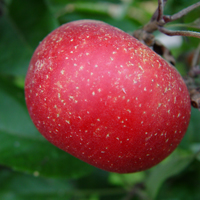
Discovery
eater
The second earliest apple in the garden after George Cave, and one of our recommended varieties. Completely trouble free with dark green, glossy foliage and bright red, sweet apples with a hint of strawberries. Like many early apples, best eaten straight off the tree as it has no keeping qualities once ripe. However, this is not a problem with a small tree or trained, as here, into an espalier, but a large orchard tree covered in 200 apples could be a problem!. A good pollinator for other varieties but in itself, not particularly self-fertile. (Langham, Essex 1949)
Egremont Russet
eater
The most well known and popular of the russets (but newer varieties are nipping at its heels, see Princesse or Herefordshire Russet)). Firm sweet flesh with that unmistakeable nutty flavour. A good pollinator for other apples but not self fertile itself. The lower arms of this espalier never crop too well as they are crowded by the bedding displays and low hedges and scab is sometimes a problem but the higher branches with more light and air movement provide some cracking apples. (This in itself is a good apple growing lesson) (Petworth, Sussex, 19th century)
Elstar
eater
A heavy cropping small to medium sized apple, crisp and juicy with a honeyed flavour. Hard thinning of the crop is needed to get large fruit. A good pollinator for other apples but not especially self fertile itself. Will store into December. (Holland 1972)
Falstaff
eater
Self fertile and good pollinator for other apples. Green with a few red stripes and excellent flavour. Good in containers and disease free. Good keeping qualities-March. (East Malling, Kent 1965)
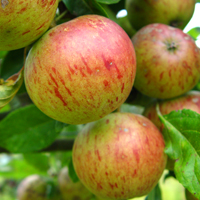
Fiesta
eater
Highly recommended for all areas of the UK but has trouble here in my garden with canker although the fruit quality is always good. Rich, aromatic and sweet with Cox flavours. Not self fertile but a good pollinator for others. Suitable for containers and carries heavy crops (East Malling, Kent 1972)
Fortune (Laxton's Fortune)
eater
Similar but sweeter than a Cox but much easier to grow. Leave fruit on the tree as long as possible to get the best flavour. Stores till late October. (Bedford 1904)
Greensleeves
eater
Crisp, tangy, all pale green apple. Good for all areas and good pollinator for other apples (Kent 1966)
Herefordshire Russet
eater
New in 2004 and highly recommended. The russet with a Cox like flavour, rich and aromatic. Small to medium sized fruit that may need thinning. Picks late Sept/Oct. Stores till January. Good for all areas, disease free and an excellent pollinator for other apples. Not officially self fertile but needs little help
James Grieve
eater
Consistently asked for by customers and I consistently put them off because here, in my garden, it never performs well, with small fruit, mildew and canker.. Maybe a good performer with spraying or in the open, unlike here, in a row of cordons.
Jumbo
dual purpose
New in 2004, planted here last year so to early for me to judge although the foliage remains clear of any problems. Large apples on a moderately vigorous plant so best on dwarfing stock. Said to have an acidic, aromatic flavour when eaten fully ripe and stores well through to March.
Joybells
eater
Excellent, sweet flavour and heavy cropping with a neat, spur bearing habit. Picks in late September or early October and stores into December. Needs a pollinator (Discovery or Katy) (Godalming, Surrey 1914)
Jupiter
eater
Like a Cox on steroids! best an dwarf rootstock and doesn't lend itself to being hemmed in, as here, in a row of cordons. An excellent garden tree. Fruit keeps till January (Kent 1966)
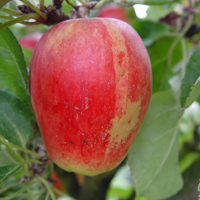
Katy
eater
The one we probably sell the most of. Easy to grow, no disease problems, with bright red, slightly oblong, fruit of excellent flavour. The third apple to crop in the garden and not a keeper although it has an extended picking period compared to other early apples. Provides good pollen for other apples though not self fertile itself. (Sweden 1947)
Limelight
eater
An improved Greensleeves type with occasional attractive blush to the sunny side. Refreshing, crisp and very disease resistant. Neat and compact-suitable for containers and all areas of the UK. (Kent 2000)
Lord Lambourne
eater
Large, bright, striped fruit. Moderately sweet with a hint of strawberries. Good for all areas. Partial tip bearer that, with hindsight, should not have been planted here, in the row of cordons, as the regular summer pruning removes many of next years flowers on the tips of branches, although short spur systems are finally developing. (Bedford, 1907)
Meridian
eater
Not planted here yet, though on sale now. Bred in 1972 introduced in 2000 with Cox and Falstaff in the parentage. Juicy, aromatic and heavy cropping with good disease resistance and keeps through till March. Should become a top seller. I shall find a space for this one!
Princesse
eater
Planted here and grown as a step-over against the coal bunker near the green house, this new russet has mysteriously disappeared from the catalogue. Far easier to grow than Egremont but with a less nutty flavour. Large fruit. Definitely will re-stock if available again
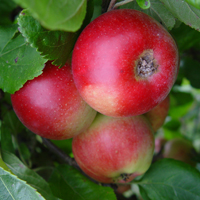
Red Devil
eater
Another of our mainstay varieties. Suitable for all areas, disease free with a superb flavour and self fertile. Keeps till December and is also suitable for container growing. What more could you ask of an apple? , it's got pink juice as well!. If only room for one apple, this should be at the top of the list. (Kent, 1979)
Red Falstaff
eater
More highly coloured form of Falstaff with a well balanced flavour. One of the heaviest yielding apples that stores well into March. Self fertile and a good pollinator for other varieties. Good in containers. (Norfolk 1983)
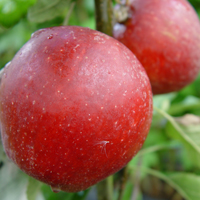
Red Windsor
eater
Heavy cropping with a superb Cox like flavour. Frost tolerant when in flower and a compact grower suitable for containers. Self-fertile and good for all areas of the UK. (Hereford 1985) A sport of Alkmene. The one we probably sell the most of
Rev. W. Wilks
cooker
Large fruit and an excellent baker which cooks to sweet, pale lemon puree needing hardly any extra sugar. Reputed to be the best early cooker whilst waiting for the Bramley's but will not keep once picked. Compact grower (Slough, Bucks. 1904)
Red Fuji
dual purpose
A Red Delicious cross with medium sized fruit, highly coloured on the sunny side. Late to pick and best left on the tree as long as possible. Excellent flavour and texture and very good keeper (Japan 1962)
Red Sleeves
eater
Bright red apples with juicy fruits of good flavour. Trouble free and good for all areas of the UK. Picks in August and into September. Does not keep. (Kent, 1986)
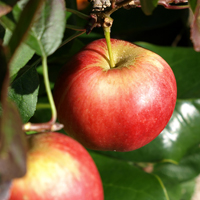
Scrumptious
eater
The new kid on the block that seems to have everything going for it and highly recommended by us. Bright red over a light green background with an exceptional flavour, a good pollinator for other apples as well as being self-fertile ,neat spur bearing habit that fruits readily on young wood, highly disease resistant and suitable for all areas of the country and does well in containers when on a dwarf stock. Fruit are thin skinned, ideal for children, and pick in September but will hang on the tree without falling off.
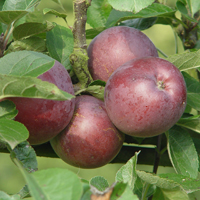
Spartan
eater
Still occasionally seen in the greengrocers for sale, this is an excellent, dark plum red apple with very white flesh and an acidic but sweet taste. A good pollinator and suitable for all areas as well as being trouble free. Fruit stores into January. (Canada 1926).
My Espalier, having been trouble free for years, has now developed canker and is losing the fight but I still recommend this one as it cropped well for years
Sunrise
eater
Great flavour and soft flesh that seems to dissolve to leave a mouthful of apple juice. Thin skinned which wasps find easy to get through in some years. Bright red, quite large fruit. Good for all areas and suitable for containers. Susceptible to scab the last 3 wet summers though..
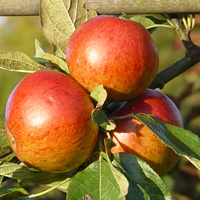
Sunset
eater
Cox like (which I think is in the parentage) but with more disease resistance. Attractive fruit with a gold background, orange flush and red stripes. Intense flavour and heavy cropper. Good in containers. (Kent 1918)
Winston
eater
One of the last to pick in late October and easily stores till April. Cox like flavour but sharper. Doesn't develop full flavour until stored for a while. (Berks. early 20th century)
Winter Gem
eater
A heavy cropping variety which consistently wins flavour contests, rich and aromatic with an attractive pink blush. Strong growing and disease free. Picks in October and stores until March (Kent 1985)
Worcester Permain
eater
Good cropper with an excellent, strawberry flavour. Attractive, deep reddish orange fruit. A good pollinator for other apples and all areas of the country. Picks in September and keeps into October. (Worcester, 19th century).
Notes
Choice of rootstock determines the final height of the tree. Never buy a fruit tree without knowing what stock it's grafted onto. Many apples sold without a label are on MM106-semi-vigorous but you can never be certain. Certain apples are triploid types which are usually more vigorous and produce pollen which is useless. In other words they don't pollinate themselves or any other apple. Bramleys Seedling and Blenheim Orange are two examples. Nearby apples, either in your own garden or the near neighbours will be important to ensure a good crop. Also, these varieties tend to produce fruit only at the ends of their branches (tip bearers) and as such don't lend themselves to formal training like fans, espaliers or cordons. Better to plant them as free standing trees, not forgetting they may need a more dwarfing rootstock to compensate for the extra vigour. Don't forget many of the ornamental Crab-apples are good for pollination. These are often smaller in size but produce more than enough pollen to do the job. Ask at the nursery for suitable varieties
